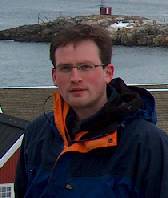Geoforensics and Information Management for crime Investigation (GIMI)
Project Staff - Andrew Wilson

Dr. Andrew Wilson
Current research activities
Much of my research is concerned with maximising the information potential of trace evidential material, in particular from hair and fibres. In humans, the rapid growth of scalp hair (~1 cm each month) provides detailed information of high chronological resolution for reconstructing recent lifehistory. For this we can use a variety of tools including stable isotopes (for diet, seasonality and movement), toxicological information (for drug use and exposure to pollutants) and histology (for environmental indicators and evidence of damage and grooming practice). Furthermore the recovery of mitochondrial DNA is now possible from hair from archaeological as well as forensic contexts. All of this biogenic information from trace evidential material can potentially be influenced by environmental insults. By examining hair subject to surface exposure and under soil burial conditions, both with and without human body analogues, we have a much better understanding of the mechanisms of hair degradation and how to overcome some of these difficulties. As part of this work, we have been conducting fieldscale taphonomic experiments within the UK, at the Anthropological Research Facility in Knoxville, Tennessee and in Southern Peru. Allied to this research is forensic casework experience, working closely with West Yorkshire Police and other UK Forces.
Recent Publications
Wilson, A.S., Janaway, R.C., Holland, A.D., Dodson, H.I., Baran, E., Pollard, A.M., Tobin, D.J. Modelling the buried human body environment in upland climes using three contrasting field sites (submitted).
Wilson, A.S., Gilbert MTP Identification from Hair & Nail in Thompson, T & Black, S Introduction to Biological Human Identification, CRC Press, Boca Raton (in press).
Wilson, A.S. The decomposition of hair in the buried body environment in Tibbett M. & Carter, D.O. (Eds.) ‘Principles of Forensic Taphonomy: Applications of Decomposition Processes in Recent Gravesoils’, Humana Press, New Jersey (in press)
Gilbert, M.T.P, Janaway, R.C., Tobin, D.J., Cooper, A., Wilson, A.S. Histological correlates of post-mortem DNA damage in degraded hair. Forensic Science International. 156, 201-207 (2006).
Wilson, A.S. Hair as a bioresource in archaeological study, in Tobin D.J. (Ed.) Hair in Toxicology: An Important Biomonitor, Royal Society of Chemistry/ Springer Verlag, pp321-345 (2005).
Gilbert, M.T.P., Wilson, A.S., Bunce, M., Hansen, A.J., Willerslev, E., Shapiro, B., Higham, T., Richards, M.P., O'Connell, T.C., Tobin, D.J., Janaway, R.C., Cooper, A. Ancient mitochondrial DNA from hair. Current Biology 14:R463-464, R1-7. (2004).

